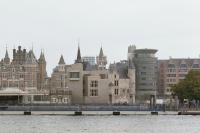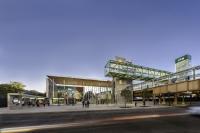Modelia Days Gokokuji
Tokyo, Japan
This apartment building is in the Otowa district of Tokyo’s Bunkyo ward, very close to Gokokuji temple, which was established in the Edo era (1603-1868) as a place of prayer for members of the shogunate. Although the neighborhood is located in the city center, it retains traces of that older era.
In order to avoid direct lines of sight between the apartment building and the residents of the single-family homes lining the other side of the narrow road on which it sits, the windows are shifted slightly off-center. This arrangement of windows brings breezes and natural light into the building while also giving the heavy concrete a lighter feeling.
The windows appear sufficiently large from inside, but the exterior surface surrounding each one slopes in at an angle, creating a recessed “frame” that heightens the impression of lightness. In addition, some of the sloped surfaces are covered with hot-dip galvanized steel sheets, while on the interior side, wooden frame-like shelf placed in the same position echo the rectangular shape of the recessed frames. This creates a loose connection between interior and exterior.
The interiors of the units are composed entirely of white walls and unadorned concrete. All unnecessary elements have been eliminated from the simple details and style. This minimalist design, which seeks the simplest possible form for an apartment building, is intended to link to a lifestyle unburdened by superfluous material possessions. We envision the minimal elements of the apartment enabling a freer lifestyle for its residents. For example, the storage space enclosed only by freestanding walls can also become a compact office, while the spacious concrete kitchen counter can serve as a desk.
The windows and wooden frame-like shelf in this building make abundant use of squares. Once we have freed ourselves from convention of modern design that dictates either a horizontal or a vertical window, squares may be the purest and most primitive shape for these openings.
Project credits:
Design Team: Ryuichi Sasaki, Rieko Okumura, Gen Sakaguchi, Anna Kwapien, Marion Foulet
Producer: Hidetaka Gonai / Modelia Co.,Ltd
Light Design: Natsuha Kameoka / Lighting Sou
Contractor: Magome Construction Company
Building Management: Alpha Management & Partners Co.,Ltd.
Client: Nobumitsu Ohashi / Shuko Kensetsu Co.,Ltd.
Location: 2-9-7 Otowa, Bunkyo-ku, Tokyo, Japan
Total Floor Area: 362.79m2
Starting Date: January, 2016
Completion Date: March, 2017
















